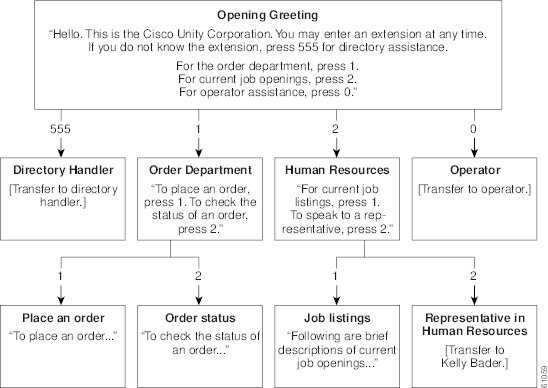

-
Cisco Unity System Administration Guide, Release 3.1(3)
-
Preface
-
Introduction
-
System Overview
-
About Subscriber Accounts
-
Call Management Tools
-
Subscriber and Operator Orientation
-
Maintaining Cisco Unity
-
Enhanced Phone Security
-
Multiple Languages
-
Integrating a Fax Server with Cisco Unity
-
Subscriber Template Settings
-
Class of Service Settings
-
Creating Subscriber Accounts
-
Subscriber Settings
-
Public Distribution List Settings
-
Account Policy Settings
-
Call Handler Settings
-
Directory Handler Settings
-
Interview Handler Settings
-
Call Routing
-
Restriction Tables
-
Reports
-
Network Settings
-
System Settings
-
Glossary
-
Index
-
Table Of Contents
Overview: Cisco Unity Call Management Tools
Creating a Call Management Plan
Call Management Planning Questions
Creating a Call Management Map
Implementing a Call Management Plan
Call Management Tools
Overview: Cisco Unity Call Management Tools
Cisco Unity provides the following tools for managing incoming calls:
Call handlers
Call handlers answer calls and can take messages; provide menus of options (for example, "For customer service press 1, for sales press 2..."); route calls to subscribers and to other call handlers; and play audiotext (prerecorded information). See the "Overview: Call Handler Settings" section on page 16-1 for more information.
Directory handler
The directory handler provides directory assistance, which is an audio listing that subscribers and unidentified callers use to reach subscribers and to leave messages. See the "Overview: Directory Handler Settings" section on page 17-1 for more information.
Interview handlers
Interview handlers collect information from callers by playing a series of questions and then recording the answers. See the "Overview: Interview Handler Settings" section on page 18-1 for more information.
Call routing tables
Call routing tables allow you to define how calls are initially routed, based on criteria such as the phone number of the caller and the schedule. Once you have set up call handlers, interview handlers, and the directory handler, as well as extensions for subscribers, you can route calls to the appropriate person or handler by modifying the call routing tables. See the "Overview: Call Routing Tables" section on page 19-1 for more information.
Restriction tables
Restriction tables control outgoing calls by allowing you to specify the numbers that Cisco Unity can dial for transferring calls, for notifying subscribers of messages, and for delivering faxes. See the "Overview: Restriction Tables" section on page 20-1 for information on how to set up and use restriction tables.
Creating a Call Management Plan
Careful planning of your system, and mapping the components—call handlers, interview handlers, the directory handler, and call routing tables—is key to setting them up efficiently. To plan your system, consider the following "Call Management Planning Questions" section as you decide which handlers you need.
Call Management Planning Questions
•
High-level structure—Will your organization use an operator or automated attendant? Will you need to set up call routing rules for direct or forwarded calls?
•
Purpose—What is the purpose of each call handler? Will it provide callers with an audiotext application (recorded information or a menu of one-key dialing options), take messages, or simply transfer calls? Will you need interview handlers?
•
Reaching the call handler—How will calls reach this call handler? Will calls be routed from another call handler? Can callers dial an extension or use one-key dialing to reach the call handler? Will this call handler answer incoming calls? Will a call routing rule route calls to the call handler?
•
Greetings—What will the greetings say? Who will record the greetings? Do you want to hire a professional to record the greetings?
•
Schedule—Will the greeting and transfer settings be the same for standard hours and closed hours?
•
Transfer options—Will calls be transferred from this call handler to ring a subscriber phone, or will they be transferred directly to a greeting? Who will receive messages from this call handler?
•
Functionality—Will caller input be allowed? Will this call handler route calls to another call handler? What action should be taken after the greeting plays? Can callers leave messages? What happens to calls after messages are left for this call handler?
Creating a Call Management Map
Once you have considered how your call management plan ought to work, create a sketch on paper that shows specifically how the handlers connect to one another. Include a menu of one-key dialing options and all possible navigation choices (such as reaching a call handler by dialing an extension or via a routing rule). Include the predefined Cisco Unity call handlers in your plan. See Figure 4-1 for an example of a basic call management map.
Figure 4-1 Sample Call Management Map
Implementing a Call Management Plan
After you have mapped your plan, write detailed scripts for the greeting of each call handler before beginning to record. When you are ready to set up your system of call handlers, start from the bottom up. That is, you first create the call handlers to which calls are routed. You must be able to select these "destination" call handlers when you create the call handlers that route calls to them. Additionally, you must create Cisco Unity accounts for the subscribers to which call handlers will transfer, before creating those call handlers.
Using Figure 4-1 as an example, you first create a subscriber account for Kelly Bader, and the handlers for Place an Order, Order Status, and Job Listings. Then you create the handlers for the Order Department and Human Resources.
In addition to mapping handlers, you also need to plan call routing tables. In the Figure 4-1 example, all new call handlers are reached through the Opening Greeting. Another alternative is to assign extensions to some of your call handlers and to route incoming calls to those extensions by using a call routing table. See the "Overview: Call Routing Tables" section on page 19-1 for more information.

 Feedback
Feedback